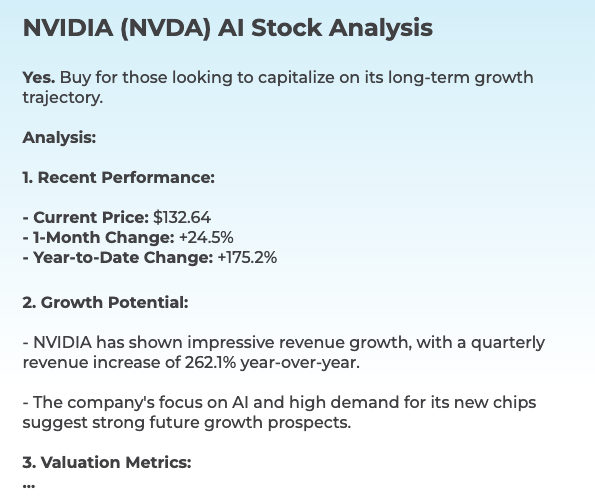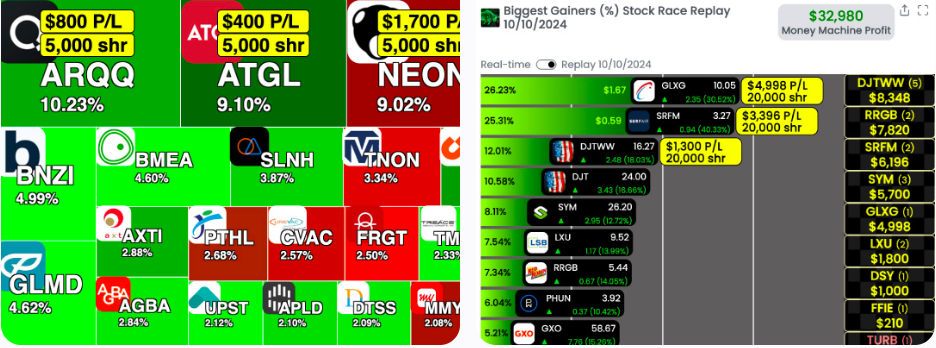20 Great Ideas On Deciding On AI Stock Picker Platform Websites
20 Great Ideas On Deciding On AI Stock Picker Platform Websites
Blog Article
Top 10 Tips To Assess The Integration And Compatibility Of Ai-Based Stock Prediction And Trading Platforms
Integrity and compatibility are crucial factors when the evaluation of AI stock predicting/analyzing trading platforms. Integrating your platform into existing tools, systems and workflows is a great way to increase efficiency. Here are 10 strategies to help you analyze the compatibility and integration of these platforms.
1. Check Brokerage Integration
Supported brokers: Ensure that the platform is compatible with your preferred brokerage account or trading account.
Trade Execution: Determine if the platform allows direct trade execution through the integrated broker.
Account Synchronization: Make sure that the platform has the ability to sync real-time balances of your account as well as positions and transaction history.
2. Assess API Availability
API access: Make sure the platform provides an API (Application Programming Interface) that allows developers to develop customized tools or to automate workflows.
API documentation - Verify that the API's examples and usage scenarios are well documented.
Rate limits: Find out if there are reasonable rate limits for the API and whether it's able to handle your anticipated usage volume.
3. Examine Third-Party Integration
Popular tools: Find out whether the platform is compatible with tools like Excel, Google Sheets, or trading bots.
Data export/import: Ensure the platform permits easy export and import of data into and out of other tools.
Extensions/Plugins: Verify whether the platform is compatible with extensions or plugins for additional capabilities.
4. Test Compatibility Operating Systems
Desktop compatibility is important. Make sure that your device works on the operating system you like (Windows MacOS Linux).
Mobile compatibility. Verify if you are able to download the app for iOS or Android.
Web-based Access: Determine if you can access the platform via a browser to increase flexibility.
5. Examine Data Integration Capabilities
Data sources. Make sure the platform supports multiple data integrations (e.g. data providers for market, social media sentiment, news feeds).
Real-time Data Feeds: Check to determine if your application offers real-time analysis.
Historical data import - Verify whether the platform permits you to add historical data to your backtesting software or analytical software.
6. Cloud and On Premise Compatibility
Cloud-based platforms : the platform should be accessible from any place with internet access.
On-premise solutions: If prefer to deploy on premises, check if the platform supports it.
Check the hybrid model. It is a hybrid model that combines on-premise and cloud capabilities.
7. Verify Cross Platform Synchronization
Device synchronization: Ensure the platform is synchronized with data and settings across devices (desktop, mobile, tablet).
Real-time updates: Check if your changes made on one device instantly show up on other devices.
Access to offline data: Determine that your application has limited functionality and data access even when you are offline.
8. Examine the compatibility of trading Strategies
Algorithmic trading: Check that the platform is compatible with algorithms or automated trading strategies.
Custom indicators: Determine if the platform allows the use of custom technical indicators or scripts.
Strategy backtesting - Check for yourself if the trading platform allows backtesting using historical data.
9. Assess Security and Compliance
Data encryption: Check whether the application uses encryption to protect data both in transit and while at rest.
Authentication : Make sure that the platform has authentic methods that are safe (e.g. 2-factor authentication).
Regulation Compliance: Make sure your platform complies with relevant regulations.
10. Test Scalability Performance
Scalability: Ensure the platform can handle an ever-growing amount of data and users to ensure that it is able to expand with your company.
Performance under load - Check that the platform is able to continue responding under conditions of extreme market volatility.
Resource usage: Check if the platform efficiently uses system resources (CPU memory, bandwidth, CPU).
Bonus Tips:
Feedback from users: Use testimonials from users to assess the platform integration capabilities.
Free Trial: Test the platform's integration with the existing workflow and tools with the demo or trial.
Customer Support: Make sure the platform offers a solid assistance to help with integration problems.
If you follow these guidelines, you can effectively assess the integration and compatibility of AI stock predicting/analyzing trading platforms in order to ensure they are compatible with your existing systems, and improve your trading efficiency. Have a look at the top market ai tips for site info including ai trading tools, using ai to trade stocks, ai for investing, ai investment app, ai stock picker, ai for stock predictions, chart ai trading assistant, ai for stock trading, chart ai trading assistant, ai for trading and more.
Top 10 Tips For Assessing The Risk Management Of Ai Stock Analysing Trading Platforms
Risk management is a vital component of any AI trading platform that predicts or analyzes stocks to protect your capital and reduce the risk of losses. Platforms that are equipped with powerful risk-management tools can help you navigate volatile market conditions and make educated choices. Here are the top 10 strategies for evaluating the risk management capabilities of these platforms. capabilities:
1. Review Stop-Loss Features and Take-Profit Features
Customizable level: You should be able to customize the levels of take-profit and stop-loss for specific strategies and trades.
Find out if you can utilize trailing stops. They automatically adjust as the market moves towards your advantage.
Guaranteed stop orders: Find out whether the broker offers guarantee stop-loss orders. These guarantee that your position will be closed at the exact price, even in volatile markets.
2. Utilize Position Sizing Tools
Fixed amount. Be sure to have the option to define your position sizes in terms of an amount that is fixed in dollars.
Percentage portfolio: Find out whether the risk can be managed proportionally by establishing your positions as a per percent of your portfolio's total.
Risk-reward: Find out if your platform permits you to determine risk-rewards for each trade or strategy.
3. Make sure you have Diversification Support
Multi-asset trading: Make sure the platform you choose to use allows you to trade across a variety of types of assets, including ETFs, stocks and options. This will help diversify your portfolio.
Sector allocation: Find out whether the platform has tools for monitoring and managing exposure to sectors.
Geographic diversification: Check if the trading platform has international markets available in order to spread risk geographically.
4. Review leverage and margin controls
Margin requirements - Ensure that the platform clearly explains the requirements for margins clearly.
Examine whether you can establish limit on leverage to limit risk exposure.
Margin calls: Make sure you receive timely notifications from the platform in order to ensure that your account is not liquidated.
5. Evaluation of Risk Analytics and Reporting
Risk metrics: Ensure whether your platform contains important risk indicators, such as Sharpe ratio and Drawdown, for your portfolio.
Evaluation of scenarios: Ensure that the platform you're using permits you to create market scenarios and analyze the risks.
Performance reports: Ensure the platform offers you comprehensive reports on performance, including returns that are adjusted for risk.
6. Check for Real-Time Risk Monitoring
Monitoring your portfolio: Make sure the platform allows real-time monitoring of your portfolio's risk exposure.
Alerts and notifications. Ensure that the platform has sent out alerts at the moment that certain risk-related events occur (e.g. margin breaches and triggers for stop-loss orders).
Risk dashboards – Check to see if your platform offers customizable risk dashboards. This will provide you with an overview of the risks you are facing.
7. Assess the effects of stress testing and backtesting
Test your strategies for stress: Ensure that the platform you choose permits the testing of your portfolio and strategies under the most extreme conditions of the market.
Backtesting - Check to see whether your platform permits you to test strategies back using historical information. This is a fantastic method to gauge the risks and determine the effectiveness of your strategy.
Monte Carlo Simulators: Verify whether the platform utilizes Monte Carlo models to model potential outcomes and determine the risk.
8. Assessment of Compliance with Risk Management Regulations
Compliance with regulatory requirements: Ensure that the platform meets the relevant risk management regulations in Europe and the U.S. (e.g. MiFID II).
Best execution : Check to see if your platform follows best execution procedures. This guarantees that trades will be executed for the best possible price, minimizing the chance of the chance of slippage.
Transparency - Check to see if the platform discloses risks in a clear, transparent manner.
9. Check for Risk Parameters that are user-controlled
Custom risk rules: Make sure the platform you select allows you to create customized risk management rules.
Automated risk controls: Check whether the platform can automatically implement rules for risk management in accordance with the parameters you've set.
Manual overrides: Make sure that the platform supports manual overrides during emergency situations.
Review user feedback and case research
User reviews: Examine user feedback to determine the effectiveness of the platform's risk management.
Case studies and testimonials: These will highlight the platform’s risk management capabilities.
Community forums: Check if a platform has a community of users who are willing to share strategies and strategies to manage risks.
Bonus Tips
Trial period: You may use a demo or free trial to test out the risk management tools on the platform.
Support for customers: Ensure that your platform has a robust assistance for any questions or concerns related to risk management.
Educational resources: Find out whether the platform has education resources or videos regarding risk management best practices.
These guidelines will allow you to determine the risk management capabilities of AI analysis and stock prediction platforms. In this way you'll be able select a platform that protects your investment and reduces the risk of losses. For trading success and to make sense of volatile markets, reliable risk management tools are crucial. View the top rated best ai trading platform for blog info including ai options trading, ai options trading, stock predictor, invest ai, ai stock trader, best stock prediction website, ai stock investing, ai stock investing, invest ai, ai for trading stocks and more.